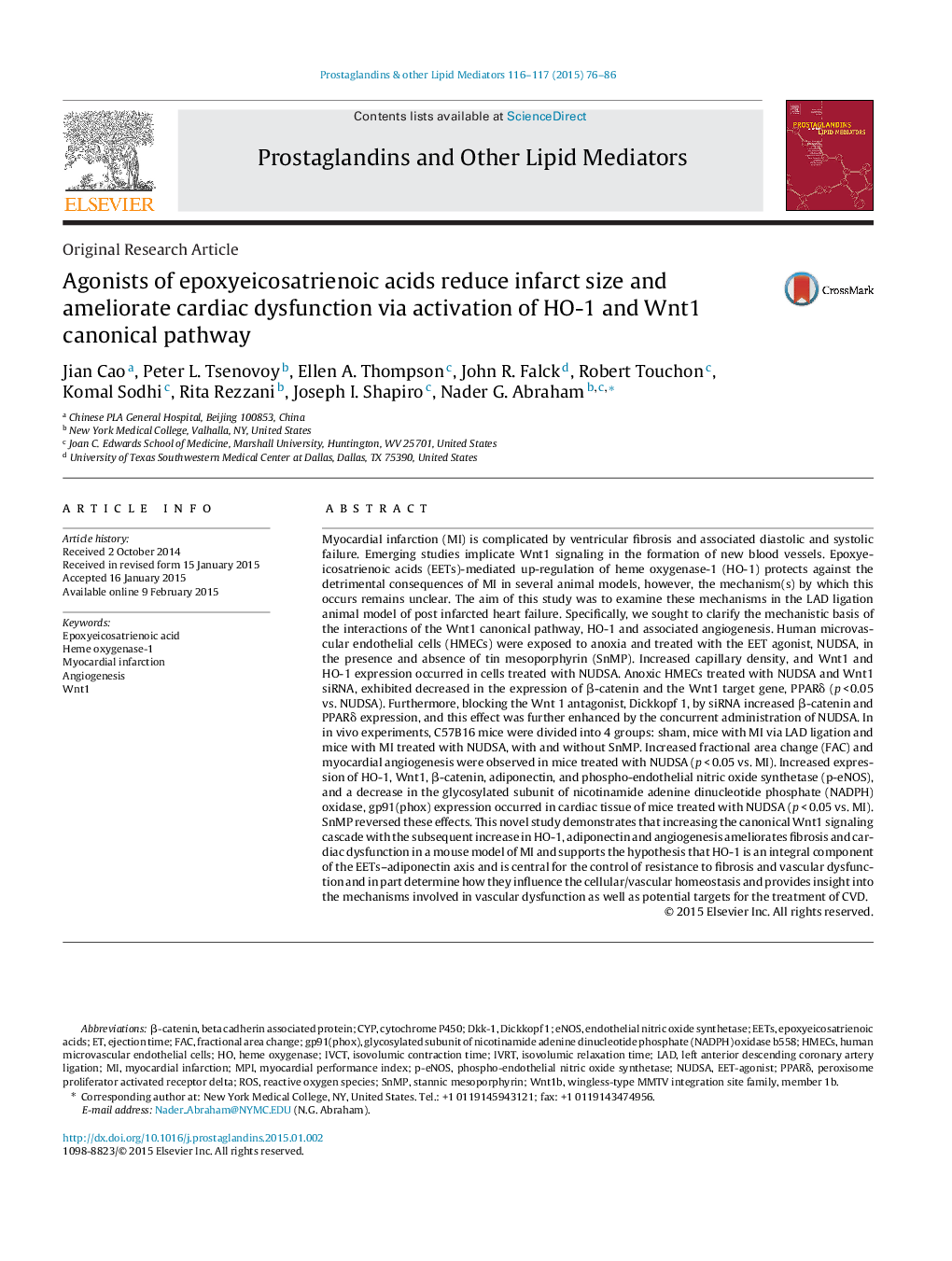| کد مقاله | کد نشریه | سال انتشار | مقاله انگلیسی | نسخه تمام متن |
|---|---|---|---|---|
| 2019617 | 1542213 | 2015 | 11 صفحه PDF | دانلود رایگان |

• Increased canonical Wnt1 signaling cascade improves cardiac function.
• Existence of an epoxide adiponectin–HO axis ameliorates cardiac dysfunction.
• LV systolic dysfunction by administration of NUSDA 5 days post cardiac remodeling.
Myocardial infarction (MI) is complicated by ventricular fibrosis and associated diastolic and systolic failure. Emerging studies implicate Wnt1 signaling in the formation of new blood vessels. Epoxyeicosatrienoic acids (EETs)-mediated up-regulation of heme oxygenase-1 (HO-1) protects against the detrimental consequences of MI in several animal models, however, the mechanism(s) by which this occurs remains unclear. The aim of this study was to examine these mechanisms in the LAD ligation animal model of post infarcted heart failure. Specifically, we sought to clarify the mechanistic basis of the interactions of the Wnt1 canonical pathway, HO-1 and associated angiogenesis. Human microvascular endothelial cells (HMECs) were exposed to anoxia and treated with the EET agonist, NUDSA, in the presence and absence of tin mesoporphyrin (SnMP). Increased capillary density, and Wnt1 and HO-1 expression occurred in cells treated with NUDSA. Anoxic HMECs treated with NUDSA and Wnt1 siRNA, exhibited decreased in the expression of β-catenin and the Wnt1 target gene, PPARδ (p < 0.05 vs. NUDSA). Furthermore, blocking the Wnt 1 antagonist, Dickkopf 1, by siRNA increased β-catenin and PPARδ expression, and this effect was further enhanced by the concurrent administration of NUDSA. In in vivo experiments, C57B16 mice were divided into 4 groups: sham, mice with MI via LAD ligation and mice with MI treated with NUDSA, with and without SnMP. Increased fractional area change (FAC) and myocardial angiogenesis were observed in mice treated with NUDSA (p < 0.05 vs. MI). Increased expression of HO-1, Wnt1, β-catenin, adiponectin, and phospho-endothelial nitric oxide synthetase (p-eNOS), and a decrease in the glycosylated subunit of nicotinamide adenine dinucleotide phosphate (NADPH) oxidase, gp91(phox) expression occurred in cardiac tissue of mice treated with NUDSA (p < 0.05 vs. MI). SnMP reversed these effects. This novel study demonstrates that increasing the canonical Wnt1 signaling cascade with the subsequent increase in HO-1, adiponectin and angiogenesis ameliorates fibrosis and cardiac dysfunction in a mouse model of MI and supports the hypothesis that HO-1 is an integral component of the EETs–adiponectin axis and is central for the control of resistance to fibrosis and vascular dysfunction and in part determine how they influence the cellular/vascular homeostasis and provides insight into the mechanisms involved in vascular dysfunction as well as potential targets for the treatment of CVD.
Journal: Prostaglandins & Other Lipid Mediators - Volumes 116–117, January–March 2015, Pages 76–86